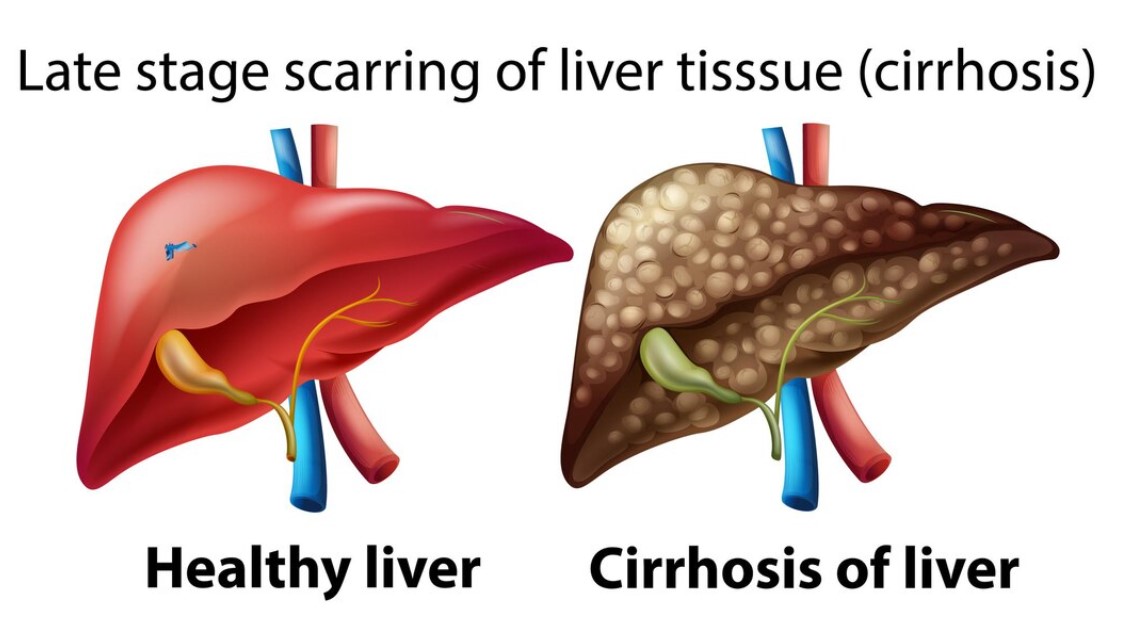
Liver cirrhosis is a serious condition characterized by the formation of regenerative nodules surrounded by fibrous tissue, resulting from long-term liver damage. This progressive disease can lead to portal hypertension and ultimately result in end-stage liver disease. Fortunately, recent advances in understanding its natural progression and the mechanisms behind it, as well as improved management strategies for its complications, have provided new hope for those affected. Today, enhanced treatment options are available, significantly improving patients’ quality of life and longevity.
Causes of Liver Cirrhosis
Cirrhosis can arise from various factors, including:
- Chronic Alcoholism: Long-term alcohol abuse, typically over a decade, is a leading cause of cirrhosis.
- Chronic Hepatitis: Hepatitis C virus infection can slowly damage the liver over many years, often spreading through blood transfusions before routine testing was implemented.
- Autoimmune Diseases: Conditions where the immune system mistakenly attacks liver cells can result in inflammation and damage, eventually leading to cirrhosis.
- Genetic Disorders: Inherited conditions like α1-antitrypsin deficiency, hemochromatosis, Wilson’s disease, galactosemia, and glycogen storage diseases increase the risk of cirrhosis.
- Infections and Medications: Liver cirrhosis can also stem from adverse medication effects, parasitic infections, or exposure to environmental toxins.
Symptoms of Liver Cirrhosis
Cirrhosis progresses in stages, with symptoms ranging from mild or absent in the early phase to more severe in the later stages. This progression places a significant burden on both patients and healthcare systems.
- Early Stage: Often asymptomatic due to the liver’s ability to compensate for damage.
- Late Stage Symptoms:
- Impaired liver function
- Portal hypertension
- Muscle cramps
- Itchy skin
- Sleep disturbances
- Sexual dysfunction
Complications in Advanced Stages:
- Ascites (fluid accumulation in the abdomen)
- Upper gastrointestinal bleeding
- Secondary infections
- Hepatic encephalopathy
- Increased risk of liver cancer
Diagnosing Liver Cirrhosis
Diagnosing liver cirrhosis involves a comprehensive approach, as no single test can definitively confirm the condition. Standard diagnostic methods include:
- Initial Screening Tests: A liver panel measures various enzymes and proteins, including alanine transaminase (ALT), aspartate transaminase (AST), alkaline phosphatase (ALP), gamma-glutamyl transferase (GGT), total and direct bilirubin, and serum albumin.
- Additional Tests:
- Complete Blood Count with Platelet Count: A platelet count below 160,000 per mm³ may indicate cirrhosis, particularly in patients with chronic hepatitis C.
- Prothrombin Time (PT) or International Normalized Ratio (INR): These tests assess blood clotting ability, which is often impaired in cirrhosis.
- Imaging Studies: Ultrasound, CT scans, or MRIs can identify liver abnormalities, such as nodules or signs of portal hypertension.
- Liver Biopsy: This invasive procedure may be used to confirm cirrhosis, evaluate its severity, and determine its cause.
Managing Liver Cirrhosis
Cirrhosis can remain compensated for many years before progressing to decompensation, marked by symptoms like jaundice, ascites, encephalopathy, or variceal bleeding. The average survival time for those with compensated cirrhosis is around nine years.
The management of compensated cirrhosis focuses on three main goals:
- Treating the underlying cause.
- Early detection and management of complications.
- Preventing additional health issues.
Healthcare providers can extend the compensated phase of cirrhosis and enhance patients’ quality of life by addressing these goals. Treatment strategies include:
- Maintaining Portal Vein Blood Supply: Doctors may ensure adequate blood flow to the portal vein and treat thrombosis with anticoagulants or interventional methods to prevent portal hypertension and variceal bleeding.
- Nutritional Support: Malnutrition affects a significant number of cirrhotic patients. Ensuring proper calorie and protein intake can prevent complications like ascites and infections.
- Regular Monitoring: Routine follow-ups and lab tests are crucial for tracking disease progression, while patient education improves overall management and outcomes.
- Palliative Care: This approach focuses on alleviating symptoms, reducing treatment costs, and potentially extending survival for those with severe illness.
Prevention and Lifestyle Modifications
Liver cirrhosis can often be prevented or managed through lifestyle changes and proactive measures. Here are some key recommendations:
- Maintain a Healthy Weight: Regular exercise and a balanced diet contribute to weight management and overall health.
- Limit Alcohol Intake: Given that alcohol is a leading cause of cirrhosis, complete abstinence is advised, especially for those with liver issues.
- Medication Management: Follow healthcare providers’ prescriptions closely, avoiding unnecessary medications and adhering to dosing instructions to prevent complications.
- Liver Health Screenings: Regular liver function tests and screenings for hepatitis B are essential, especially for at-risk individuals, allowing for timely interventions.
- Managing Underlying Conditions: Effectively control diabetes and non-alcoholic fatty liver disease through lifestyle adjustments.
- Seek Support: If needed, consider resources for preventing alcohol abuse, and consult a nutritionist for a liver-friendly diet. Vaccination against hepatitis B can also help prevent infection.
Implementing these preventive measures and lifestyle changes requires time and consistency but can significantly reduce the risk of developing liver cirrhosis and improve overall liver health.
For expert guidance on managing liver health, consult Dr. Ram C. Soni, a top gastroenterologist in Faridabad, who can provide tailored advice and treatment options for those dealing with liver issues.



